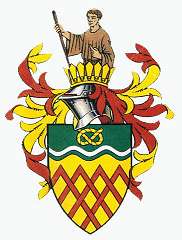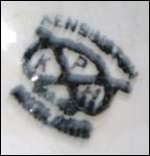|
The motto of the arms of the County of
Stafford is "The Knot Unites".


The arms of the city of
Stoke-on-Trent
with the Stafford Knot (from the Tunstall arms)
Motto - "Vis unita
fortior"
Translation - "United Strength is Stronger"


The old Tunstall borough arms


The Stafford family standard illustrated
here features the swan badge believed to have been used by the family
from their earliest days in England (they were of the richly rewarded
de Tosny castle building clan that came across with Duke William), and
the famous Stafford knot. The cross of St George placed next the hoist
was usual in the Middle Ages for Englishmen. The addition of mottoes
came in the later Middle Ages.

Coat of Arms of the
Borough of Stafford
The Stafford Knot
"The origin of the Stafford Knot is shrouded in the mists of antiquity,
but it can be said that the somewhat barbaric tale of a certain sheriff
who invented it to hang three criminals with one rope at the same time,
may be dismissed as an effort of the imagination.
The earliest authentic appearance of the
Stafford Knot is on the seal in the British Museum, and this was the
property of Joan, Lady of Wake, who died childless in 1443.
Her personal possessions passed to her
nephew, Humphrey, Earl of Stafford, who adopted the Knot of Rope,
henceforward to be known as the Stafford Knot, as his badge, probably
just preceding his creation as Duke of Buckingham in 1444. That he did
adopt it from his Aunt is undoubted and she, being a direct descendent
of Hereward the Wake, may have had it handed down to her from past
generations, through many unknown but doubtless - romantic
circumstances.
The Duke of Buckingham and his
descendants used this Stafford Knot as personal cognizance. It did not
form part of their armorial bearings, which were personal to themselves,
but it was their badge and they gave the knot of rope to their retainers
and servants as a livery and means of recognition.
The townsmen of Stafford were leigemen of
the Stafford family, and as such also used this badge. As the days of
feudalism passed and individual and civic liberties grew, it was
gradually adopted by the Citizens, Freemen and Burgesses until
ultimately it was included in the Borough Coat of Arms. Even following
Local Government Reorganisation in 1974, the Stafford Knot still appears
on the Coat of Arms of the new Stafford Borough."
courtesy: Stafford Borough Council
|
![]() | back to examples of the knot on pottery |
| back to examples of the knot on pottery |






